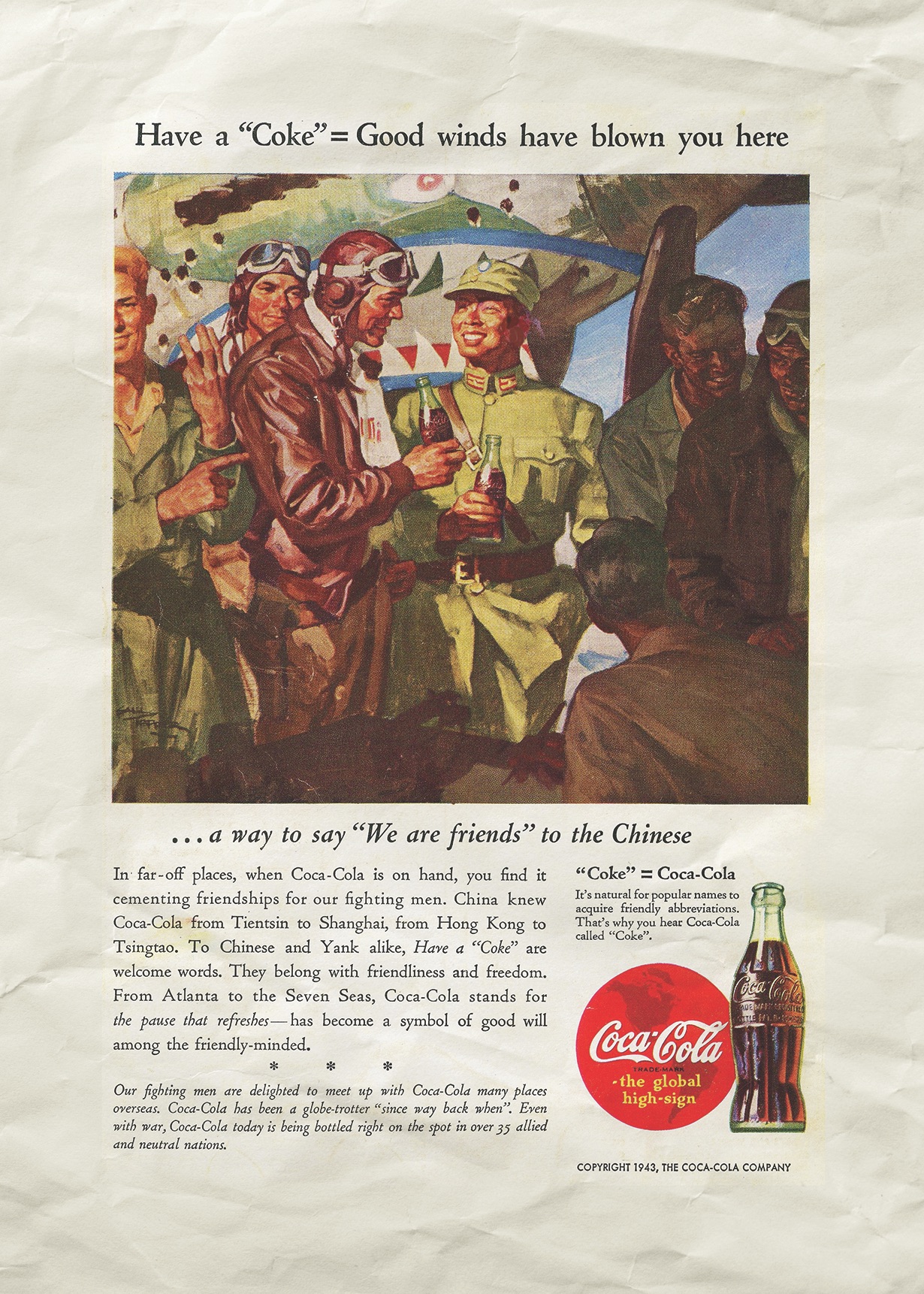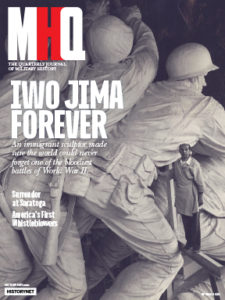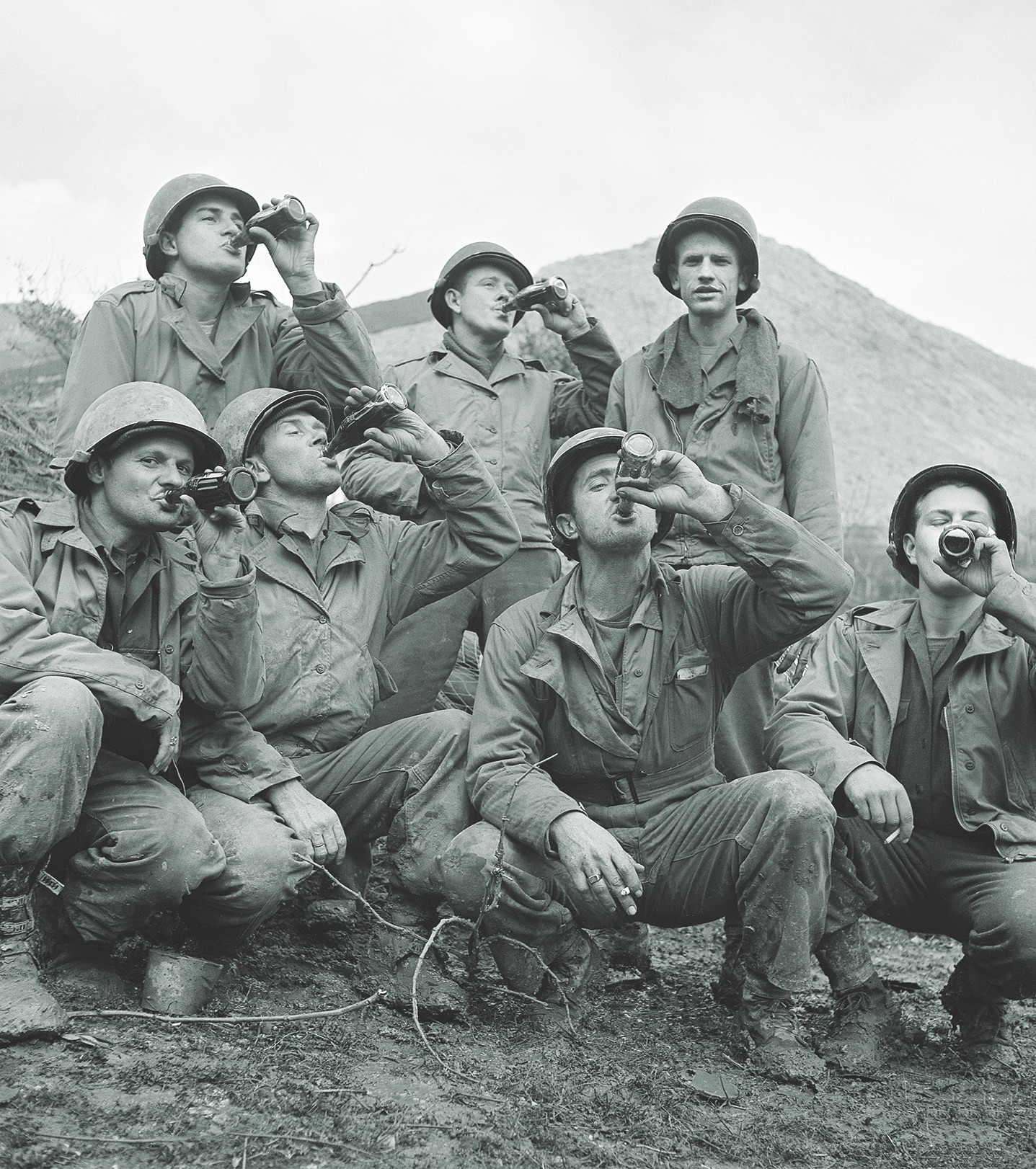“We will see that every man in uniform gets a bottle of Coca-Cola for five cents, wherever he is, and whatever it costs the company.”
Caffeine—a mild stimulant typically ingested in the form of coffee or tea but also consumed in caffeinated energy drinks and soft drinks such as Coca-Cola—is the world’s most popular mood-altering drug. Billions of people rely on it daily to boost energy and mental alertness and fend off drowsiness. It is also considered one of the world’s most benign drugs.
Unlike alcohol and tobacco, caffeine does not kill—at least not short of extreme doses equivalent to 60 to 90 strong cups of coffee for a 200-pound adult. Nevertheless, the drug has been complicit in plenty of killing. Caffeine has kept armies awake and alert, energized empires and rebellions, and otherwise helped to mobilize the world’s militaries. “When there is fatigue and the food is diminished,” U.S. Army brigadier general Michael Ryan Morgan observed in 1896, “such a stimulant is indispensable, and must be an ingredient of every reserve and emergency ration.”
Caffeine was first isolated in 1819 by German chemist Friedlieb Ferdinand Runge. Caffeine is certainly not unique to tea leaves and coffee beans—more than 100 other plants contain the alkaloid, including the guarana climbing vine, the kola nut, the yerba mate tree, and the guayusa holly tree—but no other source of the drug approaches the significance of tea and coffee, the most widely consumed beverages on the planet apart from water. Tea was an essential ration for British and Canadian soldiers around the world, and coffee was just as important to Union and Confederate soldiers in the Civil War. (“If your men get their coffee early in the morning,” Union major general Benjamin Butler assured another general, “you can hold.”)
Coca-Cola, the pioneer of caffeinated soft drinks, was named after its two defining ingredients: the coca leaf and the kola nut. As the first advertisement for the drink in the Atlanta Journal on May 29, 1886, put it: “Coca-Cola. Delicious! Refreshing! Exhilarating! Invigorating! The new and popular soda fountain drink containing the properties of the wonderful Coca plant and the famous Cola nut.” Andean coca leaves contain small quantities of the alkaloid drug cocaine, while the nuts of the West African kola plant contain about 2 percent caffeine. Cocaine was removed from Coca-Cola in 1903, but caffeine remained, albeit at a lower level than the original formula.
John Stith Pemberton, the Georgia pharmacist who invented Coca-Cola in 1886, touted it as a “valuable brain tonic” that could cure headaches, relieve exhaustion, and calm nerves. Pemberton, however, sold the rights to the drink shortly before he died in 1888 and never got to see it become “a national drink,” as he had once predicted.
By 1895 Coca-Cola was being sold in every state in the union, and by World War I the drink had found its way into military bases and camps from coast to coast. In 1918 an officer of the 55th Infantry Exchange at Camp MacArthur in Waco, Texas, pleaded with the local bottling company for more. “Unless we have Coca Cola we will have to admit defeat at the hands of Enemy Heat & Thirst,” he plaintively wrote. “The Army has been schooled to like and want Coca Cola because Coca Cola is the wholesome thirst quenching drink and this Exchange, representing Four Thousand Coca Cola drinkers, begs that our supply be multiplied by ten and even more if possible.”
Over the next 20 years, Coca-Cola remained enormously popular in the United States and found its way to Cuba, Canada, and Germany. But it took the massive stimulus provided by World War II to transform Coca-Cola into a global beverage. As Mark Pendergrast puts it in his unauthorized history For God, Country, and Coca-Cola, “The Japanese didn’t realize that by bombing Pearl Harbor they were indirectly giving the Coca-Cola Company a worldwide boost that would ensure the soft drink company’s unquestioned global dominance of the industry.”
As the United States entered World War II, Robert Woodruff, the president of the Coca-Cola Company, boldly ordered that “every man in uniform gets a bottle of Coca-Cola for five cents, wherever he is, and whatever it costs the company.” This patriotic gesture was also a savvy business move. And the demand was certainly there: “We sincerely hope that your Company will be able to continue supplying us during this emergency,” one officer wrote in a letter. “In our opinion, Coca-Cola could be classified as one of the essential morale-building products for the boys in the Service.” Coca-Cola, with the army’s blessing, used 100 such letters in 1942 to successfully lobby Capitol Hill lawmakers to exempt the company from the sugar ration. Coca-Cola’s Washington lobbyist even managed to get an executive of the company appointed to the sugar-rationing board. Rival soft-drink makers received no such similar preferential treatment and had to sharply cut production. The Pepsi-Cola Company’s complaints that Coca-Cola had unfair access to military bases fell on deaf ears in Washington. Coca-Cola could use the conflict to simultaneously beat its domestic rivals and boost foreign sales.

Still, there was the logistical challenge of getting Coke into the eager hands of the more than 16 million thirsty American soldiers fighting overseas. Shipping the bottles was inefficient and cumbersome, especially in wartime. The solution, wherever possible, was to set up bottling plants in military bases so that the company needed only to ship its syrup. The company deployed 248 employees to build and maintain 64 bottling facilities across the world, mostly paid for by the military, that would serve 16 billion Cokes during the war. Coca-Cola representatives were even deemed “technical observers”—the official status granted to civilians necessary to the war effort—wearing “T.O.” as a shoulder patch on their army uniforms and nicknamed “Coca-Cola Colonels.”
Far from being resented for having avoided the draft and staying safe behind the front lines, the technical observers from Coca-Cola “were deemed as vital as those [T.O.s] who fixed tanks or airplanes,” according to Pendergrast. They even developed a portable soda dispenser for use in the jungle and a slimmed-down version that could squeeze through a submarine hatch. Throughout the war, the company even made sure that its product was accessible to those living near U.S. military bases abroad. Consequently, as author Tom Standage noted in A History of the World in 6 Glasses, “People around the world, from Polynesians to Zulus, tasted Coca-Cola for the first time.”
The Coca-Cola archives are filled with letters from appreciative servicemen who equated America with Coca-Cola. “To my mind, I am in this damn mess as much to help keep the custom of drinking Cokes as I am to help preserve the million other benefits our country blesses its citizens with….May we all toast victory soon with a Coke,” one wrote. “If anyone were to ask us what we were fighting for,” another soldier wrote, “we think half of us would answer, the right to buy CocaCola again.”
And it wasn’t only the foot soldiers who felt this way. Such famous generals as Dwight D. Eisenhower, Douglas MacArthur, and George S. Patton Jr. were also famously fond of Coke. In June 1943 Eisenhower made sure the Allied campaign in North Africa did not go without its Coca-Cola supply, sending a telegram order for “three million bottled CocaCola (filled) and complete equipment for bottling, washing, capping same quantity twice monthly. Preference as to equipment is 10 separate machines for installation in different localities, each complete for bottling twenty thousand bottles per day. Also sufficient syrup and caps for 6 million refills.” Quartermasters at U.S. bases lobbied equally hard for their Coke supplies: Colonel John P. Neu, the quartermaster at an American base in Dutch Guiana, pleaded for bottling equipment in early 1942, arguing that it was “vital to the maintenance of contentment and well-being of the military personnel stationed at this far away post.”
Immediately after D-Day Coca-Cola also entered Western Europe; indeed, its name was even adopted as a password by U.S. soldiers as they battled across the Rhine. After the invasion of Normandy, one U.S. soldier joked in a letter to his sister:
The most important question in amphibious landings: Does the Coke machine go ashore in the first or second wave? I’ve told you before what a problem this is. If you send the Coke machine in with the first wave, future waves come pouring in without enough nickels. Obviously, getting change for a dime or a quarter on an enemy beach is quite difficult. On the other hand, if you hold the Coke machine up until the second wave, the men of the first wave wait on the beach for it to come in, instead of driving forward to attack the enemy.
Back in the States, the company’s advertisements promoted a patriotic image, highlighting its contribution to the war effort. One advertisement depicted American sailors enjoying a Coke aboard ship, with the caption “Wherever a U.S. battleship may be, the American way of life goes along….So, naturally, Coca-Cola is there, too.” At the same time, Germany and Japan, which before the war had imported Coca-Cola, now denounced the drink. Japanese propagandists proclaimed, “With Coca-Cola we imported the germs of the disease of American society,” and their counterparts in Germany derided America for having “never contributed anything to world civilization except chewing gum and Coca-Cola.”
Behind the scenes, company executives scrambled to secure the key ingredients to keep the Coke flowing. This included encouraging Monsanto Chemical Company to build special caffeine manufacturing plants in Brazil and Mexico and turning to recycled bottle caps to cope with metal shortages. The company faced constant threats of shortages of both vanilla extract (25,000 gallons needed per month) and the coca leaf and kola nut extract referred to as Merchandise No. 5 (a million pounds needed per year).
When the fighting finally ended, few companies were as well positioned as Coca-Cola to take advantage of postwar business opportunities. After all, the U.S. military had bankrolled the startup costs of the company’s extraordinary global expansion. And the military-sponsored bottling facilities kept running for another three years before shifting to civilian operation. By that time, author Standage observes, “with the exception of Antarctica, Coca-Cola had established itself on every continent on Earth, carried on the coattails of the American military.’’ In the words of one company official, the war had guaranteed “the almost universal acceptance of the goodness of Coca-Cola.’’
Even some Soviet leaders became Coke drinkers. Among them was Georgy Konstantinovich Zhukov, the celebrated marshal who led the Red Army into Berlin at the end of the war. Eisenhower introduced Zhukov to Coca-Cola during their negotiations over the postwar carving-up of Germany, and the Soviet marshal liked it so much that he asked whether a special colorless version—to make it look like vodka—could be made just for him. With President Harry S. Truman’s blessing, Coca-Cola was happy to comply with the request and sent Zhukov shipments of unlabeled bottles sporting white caps with a red Soviet star.
During the Cold War, Coca-Cola came to be either denounced or embraced as a symbol of American consumer capitalism. Coca-Cola’s aggressive postwar expansion into foreign markets was interpreted in many places as a form of U.S. imperialism. The term Coca-colonization was coined by French communist sympathizers, who hoped to block the building of new bottling plants in their country and even argued that the drink was poisonous and should be banned. French mobs overturned Coca-Cola trucks and broke bottles in protest. Austrian communists warned that the local Coca-Cola plant could double as an atom bomb factory. Italian communists went so far as to charge that the drink turned children’s hair white.
Nonetheless, Coca-Cola became ever more popular throughout Western Europe and across the globe. And when the Berlin Wall came down in 1989, East Berliners were soon seen standing in line to buy it by the crate from the Coca-Cola bottling plant in West Berlin.
Peter Andreas is the John Hay Professor of International Studies at Brown University. He is the author of Killer High: A History of War in Six Drugs (Oxford University Press, 2020), from which this article is adapted.
[hr]
This article appears in the Spring 2020 issue (Vol. 32, No. 3) of MHQ—The Quarterly Journal of Military History with the headline: Behind the Lines | Quench Warfare

Want to have the lavishly illustrated, premium-quality print edition of MHQ delivered directly to you four times a year? Subscribe now at special savings!





